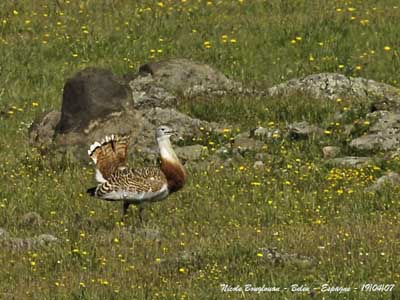
OTIDIDAE
Bustards, Floricans and Korhaans
This Old World family belongs to the Order Otidiformes and includes highly terrestrial birds, often seen walking slowly or even staying motionless among the vegetation of plains and steppes. But if they do not fly very often, when they do take wing, they are able to sustain strong flight.
Bustards can be very large, but there are some smaller species too.
These birds are well known for their elaborated courtship displays, with spectacular transformation of the appearance, jumps, foot-stamping and dramatic leaps into the air in order to attract the females.
Text by Nicole Bouglouan
Photographers :
José Luís Beamonte
Pájaros de España
Didier Buysse
Vision d’Oiseaux
Jean Michel Fenerole
Photos d’Oiseaux
Steve Garvie
RAINBIRDER Photo galleries
Ken Havard
His Bird Pictures on IBC et Flickr gallery
Patrick Ingremeau
TAMANDUA
Tom Merigan
Tom Merigan’s Photo Galleries
Niraj V. Mistry
Photo Galleries
Callie de Wet
GALLERY
Nicole Bouglouan
PHOTOGRAPHIC RAMBLE
Sources :
HANDBOOK OF THE BIRDS OF THE WORLD Volume 3 by Josep del Hoyo-Andrew Elliott-Jordi Sargatal - Lynx Edicions - ISBN : 8487334202
THE HANDBOOK OF BIRD IDENTIFICATION FOR EUROPE AND THE WESTERN PALEARCTIC by Mark Beaman, Steve Madge - C.Helm - ISBN: 0713639601
L’ENCYCLOPEDIE MONDIALE DES OISEAUX - Dr Christopher M. Perrins - BORDAS - ISBN: 2040185607
BIRDS OF THE GAMBIA AND SENEGAL by Clive Barlow and Tim Wacher – Helm Field guides – ISBN: 0713675497
ENCYCLOPEDIE DES OISEAUX DE FRANCE ET D’EUROPE – de Peter Hayman et Rob Hume - Flammarion – ISBN : 2082009920

Otis tarda
Bustards have both stout and tapering bodies, depending on the posture. Legs are long and robust, but feet lack the hind toe used by other species to grip a perch. Bustards never use trees and spend all their life on the ground, except when in flight!
In the genera Otis and Ardeotis, males are very large and heavy with about one metre in height, and a weight reaching sometimes between 10 and 24 kg, with an average of about 15-18 kg. The Great Bustard (Otis tarda) may reach up to 18-24 kg, and equally with the Mute Swan (Cygnus olor), this species is the heaviest flying bird in the world. In all genera, females are much smaller than males.
The smallest species are the Lesser Florican (Sypheoitides indica), the Savile’s Bustard (Lophotis savilei) and the Little Bustard (Tetrax tetrax).
The latter has shorter legs and neck, and it is very difficult to find it when motionless among tall grasses and flowers.
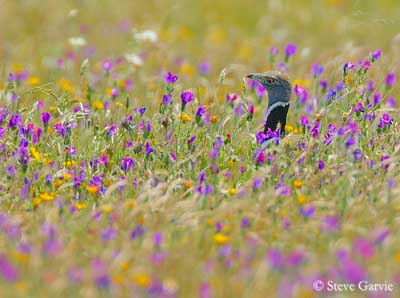
Tetrax tetrax
Usually, bustards have cryptic plumage, often with sand, tawny or buff wings, tail and mantle, with numerous sepia or black vermiculations and arrows. When in flight, the wings reveal large white areas on both sides.
Underparts can be pure white in open country species. However, the bustards living in high vegetation often have black neck and belly contrasting with the rest of the body.
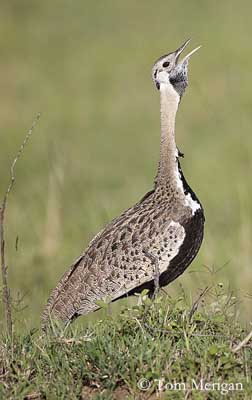
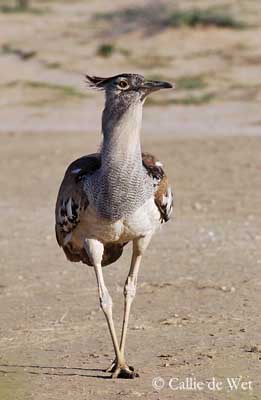
Black-bellied Bustard
Lissotis melanogaster
Ardeotis kori
Many species have greyish or bluish-grey neck with rufous hindneck and breast sides. Head often shows black and white, but most species have individual crown pattern, with a slight crest, more or less developed.
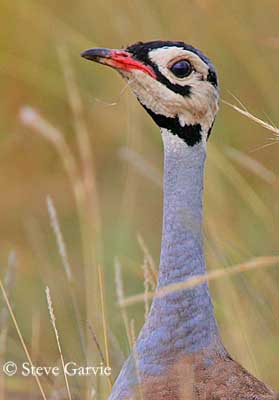
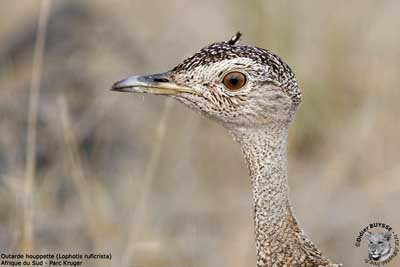
White-bellied Bustard
Eupodotis senegamensis
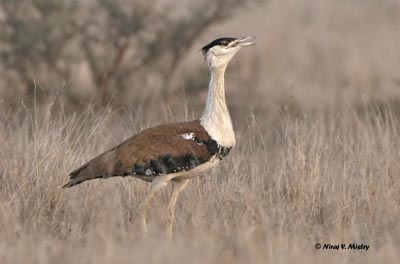
Legs and feet are dull yellow, the bill is horn-coloured and the eyes vary from dark brown or brown to yellow.
Some species such as the members of genus Afrotis may have brighter bare parts.
Great Indian Bustard
Ardeotis nigriceps
There is some sexual dimorphism. Usually, males have brighter plumage than females which show cryptic plumage, necessary when they incubate on the ground. Chicks are similar and remain well camouflaged among the grass.
Males develop some peculiar features in the breeding season, such as elongated filamentous breast feathers very conspicuous in Houbara Bustard (Chlamydotis undulata), the brushy greyish “moustaches” in male Great Bustard or the lovely spatulate feathers growing from the cheeks of male Lesser Florican. Other species have less conspicuous features, only visible during the displays.
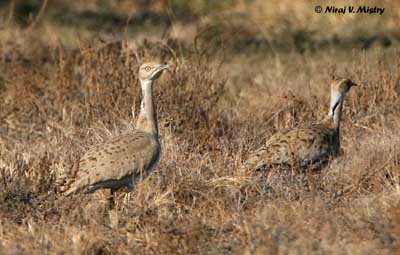
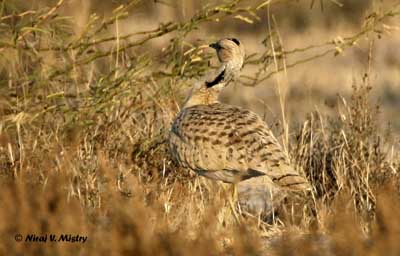
Bustards do not sing, but they utter some contact notes, mainly between female and chicks, and some self-advertising sounds such as booming, grunting and grating noises.
Usually, the larger bustards are mainly silent except the young males Great Bustard which can sometimes give a gruff nasal noise when moving among other bustards in groups.
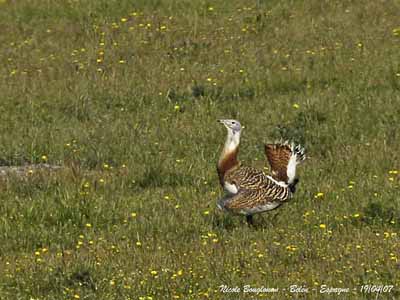
Otis tarda
All Ardeotis males give a far-carrying guttural sound during the displays, varying from a roar in Australian Bustard (Ardeotis australis), a deep boom on the Great Indian Bustard (Ardeotis nigriceps), series of drumming notes in the Kori Bustard (Ardeotis kori), and a liquid double-note in the Arabian Bustard (Ardeotis arab).
Other species also utter display calls, but often difficult to hear (too distant or too windy conditions), but these large birds are usually mainly silent.
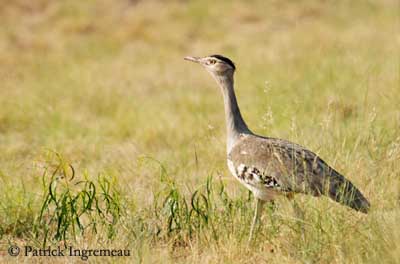
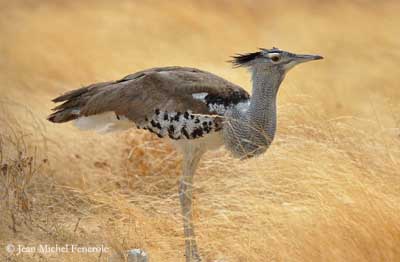
Calls are rare in this family, but the Bengal Florican (Houbaropsis bengalensis) utters a repeated “chik” call in threat displays. This call is also used more rapidly in flight displays, but in this case, the wing-flapping is more audible than the call.
The Lesser Florican also uses the wing-flapping during the dramatic leaps, with a kind of “frog-like croak” at the peak of the leap.
The best known bustard’s sound is that of the Little Bustard, a whistling noise produced by the wings during the flight, when the male performs shallow, rapid wing-beats. It also produces a brief sneezing snort-call “prrret”, also uttered repeatedly during the breeding season.
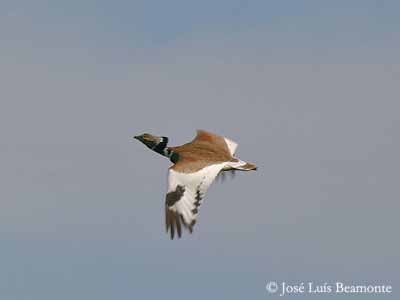
Tetrax tetrax
The African bustards are the noisiest of the family. They utter calls and songs, rather similar to noises than notes.
The three Lophotis species are the only Otididae to produce clear whistles. The Red-crested Korhaan (Lophotis ruficrista) gives an accelerated series of clicks, then, a very loud “kyip” notes, and at the end, a long series of piping “ki-kiwii ki-kiwii ki-kiwii” calls.
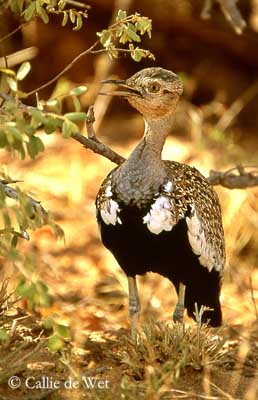
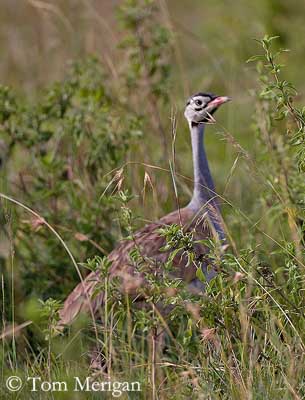
Red-crested Korhaan
Lophotis ruficristata
White-bellied Bustard
Eupodotis senegalensis
Other Eupodotis such as Karoo and Rüppell’s Korhaans perform duets led by the male. These calls can be heard at great distance.
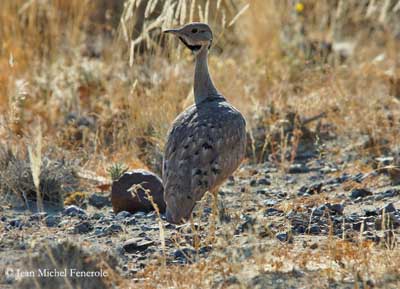
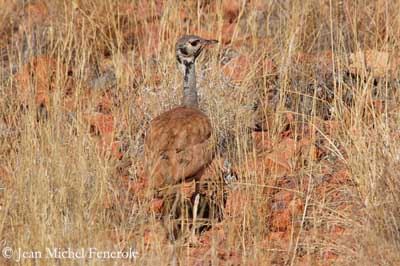
Bustards frequent mainly tropical grassy open plains, usually below 2000 metres of elevation in seasonally dry areas. Other types of habitat have been colonised, such as near-desert and salt-steppes, but also dense bushland and thorny countries.
The genera Ardeotis, Eupodotis, Houbaropsis, Neotis, Otis, Sypheotides and Tetrax are exclusively found in open landscapes with low vegetation allowing long-distance vision. They live in these habitats where they feed, sleep, display and nest. These wide horizons serve as anti-predator strategy, because these birds are vulnerable when nesting on the ground.
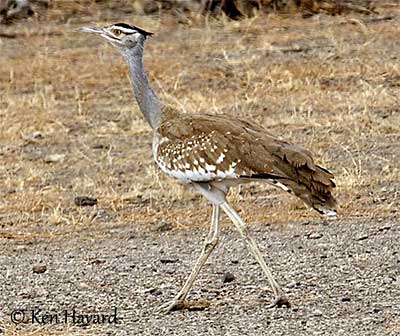
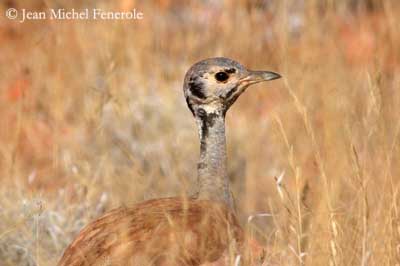
Other genera, Afrotis, Lissotis and Lophotis usually prefer bush habitats such as light woodland, thorny country, high scrub and tall grass in savannahs and on the sides of water bodies. These bustards are smaller than the previous, and can make rapid take-off if attacked.
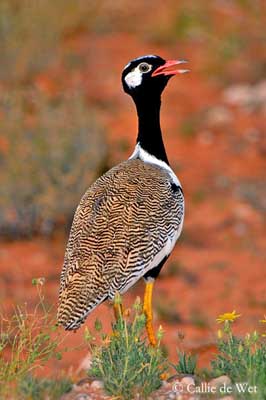
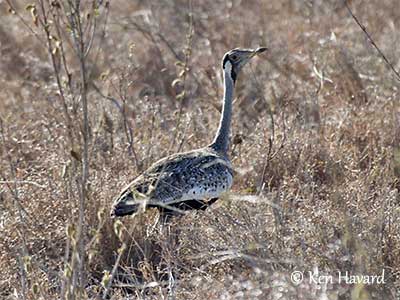
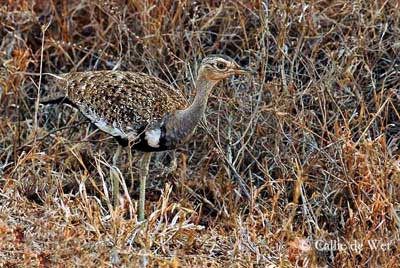
Northern Black Korhaan
Afrotis afraoides
Red-crested Korhaan - Lophotis ruficristata
Nesting sites often are in the same areas, but more concealed in vegetation. The Great Bustard nests among high cereal crops, Bengal Florican breeds in tall, dense grassland and Kori Bustard uses semi-open groves of trees.
Numerous species of bustards accept farmland if it is worked in traditional way. Great and Little Bustards live on areas cleared and worked by humans. In South Africa, Denham’s, Ludwig’s and Blue Bustards live on cultivated areas almost all year round.
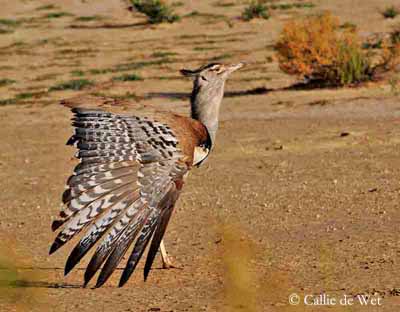
Ardeotis kori
Bustards are omnivorous and opportunistic. They know how to take advantage of food sources, animal or plants. The short, straight, stout bill is a strong tool for all types of feeding behaviours.
Bustards are mainly insectivorous, the plant matter being only supplementary food. They can take green shoots, flower heads and fresh leaves in the European steppes. They dig up roots and bulbs, and feed seasonally on fruits and berries.
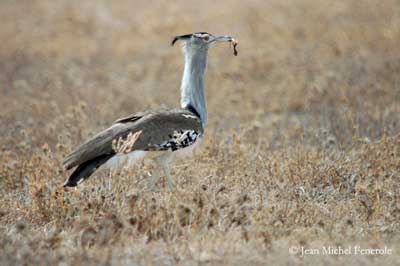
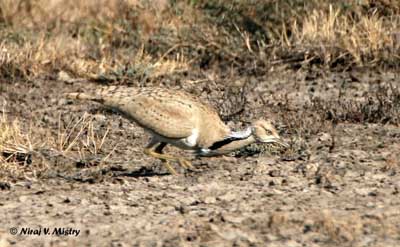
In Africa, the Arabian Bustard feeds on Acacia gum, probably for its water content and nutritional value. This species also takes locusts and swarming grasshoppers. The Northern Black Korhaan (Afrotis afraoides) and other species are known for their significant role in reducing the impact of agricultural pests such as termites.
They can sometimes take some carrion on the road side, but beetles and grasshoppers are their main food. They also take crickets, termites, caterpillars, mantises, ants and bugs, but spiders, scorpions, centipedes, and snails are also consumed.
But they can eat occasionally some vertebrates such as small snakes and lizards, eggs and chicks of other ground-nesting birds’ species. The Great Bustards take relatively frequently small mammals, and some others may feed on amphibians too.
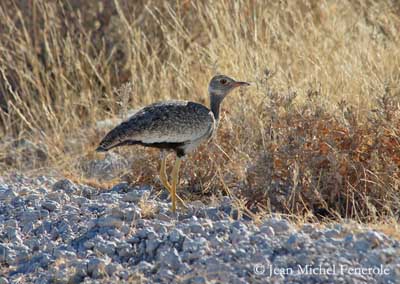
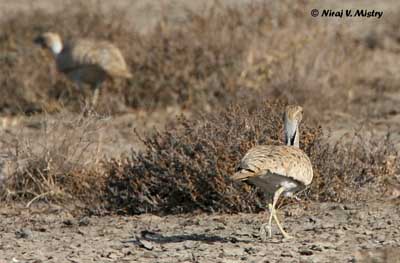
To feed, the bustard walks slowly with the bill pointing down, searching for preys. Then, it gives short pecks at the item, plant or animal. Larger insects such as grasshoppers are briefly processed by the bill before to be swallowed. The bird may run sometimes, to pursue and catch a moving prey, or jump in order to capture an insect or to take berries from the vegetation.
These birds are well adapted to dry environment, and if water is lacking, the vegetable materials give them some water.
The large species are relatively gregarious. The Great Bustard is often seen in small or loose flocks, sometimes more. They often are associated to cattle, taking advantage of insects flushed by the mammals.
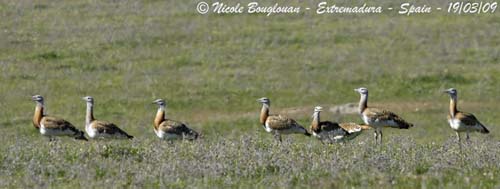
Otis tarda
The desert species such as Houbara and Nubian Bustards are less sociable. The other species may migrate and feed in loose flocks, but they are usually solitary. As in other birds’ species, flocks are larger in winter.
In the largest species, males and females are often separated, except at abundant food source.
But the most gregarious is the smallest, the Little Bustard. These birds may form very large flocks of thousands from autumn to early spring, that involve better protection against attacks by large raptors.

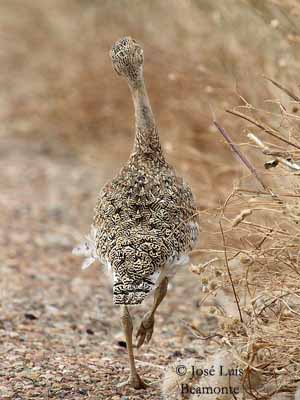
Tetrax tetrax
As they nest on the ground, bustards are vulnerable to predation by large eagles and falcons, but also by snakes or mammals. The incubating females are well camouflaged thanks to the cryptic plumage, but in addition, they adopt a typical posture by pressing close to the ground in snake-like fashion and remain motionless. The chicks do the same, and respond to her different vocalizations, including those asking silence.
In front of ground predators, bustards use some displays. The bird faces the predator with the body held forwards, the tail is raised and fanned and the wings partially open and dropped. This posture gives the bird a larger appearance and may discourage closer approach. The female may also use the “injury-feigning” display in intense alarm, in order to lead the predator away from the nest.
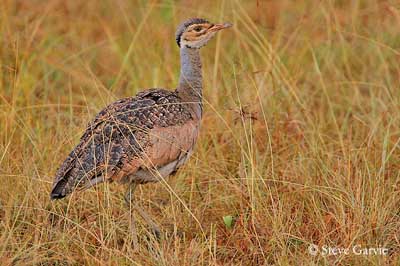
White-bellied Bustard Female
Eupodotis senegalensis
Bustards are active in the early morning and late afternoon. They rest quietly in the midday hours. Feather maintenance is an important activity, and involves dust-bathing and then, preening with the bill.
They roost at night and move to a place allowing them to see the surroundings. The Great Indian Bustard roosts in open, bare areas in response to the presence of terrestrial predators such as wolves.
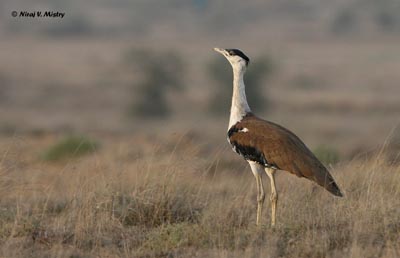
Great Indian Bustard
Ardeotis nigriceps
Bustards are well known for their mating behaviour and associated displays. Males do not perform any nesting duties, and female is left entirely alone for incubation and rearing of the young.
The open-country species need to defend food resources and nesting site, involving pairs apparently monogamous year round and territorial defence. We can often note the help of an extra bird, usually a young male offspring of the pair. The young male needs several years before to be sexually mature, and does not present any threat to the parent male.
Group-territorial behaviour occurs in some African bustards such as Rüppell’s, Karoo and Blue Bustards, but probably also in the Little Brown and the White-bellied Bustards.
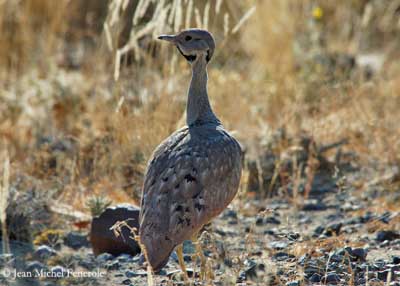
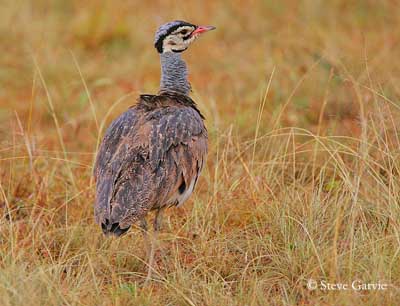
White-bellied Bustard Male - Eupodotis senegalensis
The young males develop year after year the appearance of mature birds, but they are lighter and have less experience. They try to perform some displays but their postures are incomplete and chiefly aggressive. Some sudden fights may occur between them, during which the young males test their strength and displays, in order to contest a future place in the lek.
Great Bustards do not fight frequently, because the mature males maintain distances from each other. But such confrontations involve a long face-to-face, and if the fight occurs, it can be violent and may produce an intense stress for the birds.
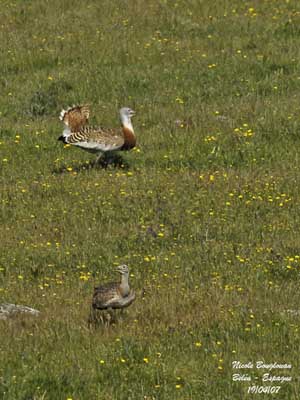
Year after year, a hierarchy builds up among the males, and the most powerful dominates the lek area. This species has a non-territorial lek system. The dominant male walks slowly into the lek and displays at different places. Females are concentrated at the edge of the lek and move slowly through it, watching the males’ performances. Then, a female approaches the displaying male very cautiously and often copulation occurs.
The Great Bustard remains silent during the displays which are spectacular. The male performs the typical “wheel” in order to attract females. For that, he performs a complete transformation and his body becomes as “foam-bath”, that is the other name of these displays. The bird pulls back the head over the back and inflates the gular sac. The bill is raised upright, as the long barb feathers. The tail is fanned and laid flat on the back, in order to expose the pure white undertail coverts. Then, the inner secondaries are twisted over and fanned out.
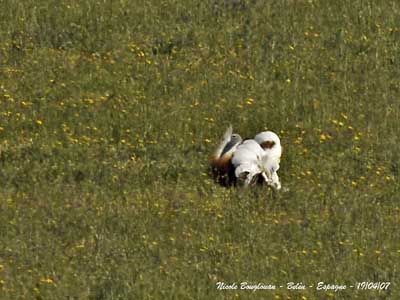
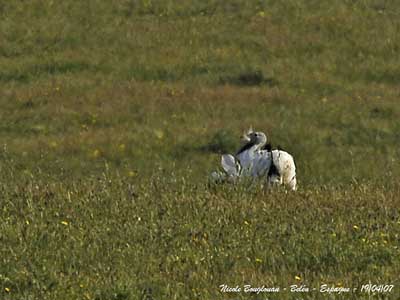
In the other large bustards of genus Ardeotis, each male seems to establish a territory from which other males are excluded. The Great Indian Bustard has very large areas. The Australian Bustards have small territories which are usually clustered, and the birds are within sight and sound of each other. Territories are often close to food sources.
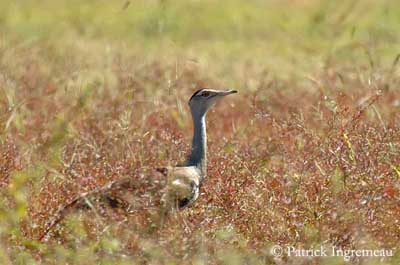
Ardeotis australis
The Denham’s Bustards in South Africa establish territories in a dispersed lek with males at least 700 metres apart. The same species in Kenya perform boundary displays and walk parallel to each other along the edges of their areas.
Several species have traditional display territories, with more or less distance between each male. These areas are used years after years and defended rather by males than females.
Displays may differ from one species to another. The more spectacular is that of the Great Bustard, but others also have elaborated displays.
The birds of the genus Eupodotis have first vocal signals. In addition, the crown, throat and neck feathers often are erected during the courtship, and rapid head-bobbing is observed in Blue Bustard.
We find two main forms of displays in other members of this family.
Ten species in the genera Otis, Ardeotis, Neotis and Chlamydotis perform only terrestrial displays, whereas eight species of Lissotis, Lophotis (except “savilei”), Afrotis, Sypheotides and Houbaropsis perform aerial displays. The Little Bustard of the genus Tetrax performs clearly aerial displays but it is inescapably terrestrial in nature.
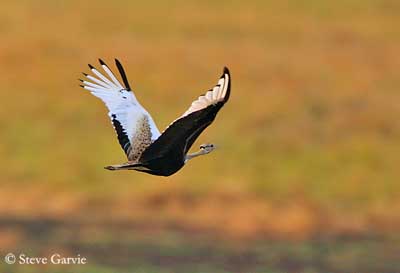
Black-bellied Bustard
Lissotis melanogaster
Both Ardeotis and Neotis show neck-inflation called “Balloon-displays”. Australian and Great Indian Bustards in addition, hold the body upright, neck and head pointed upwards and tail cocked flat on the back. Then, the bird rotates with the sacs swinging about and the bill regularly opened and closed. This display is repeated several times before to utter the long-guttural roars while the bird turns in all directions to give its call.
The two other Ardeotis, Arabian and Kori Bustards, once the sacs inflated, walk to a slight prominence to display and utter some liquid “puk-puk”.
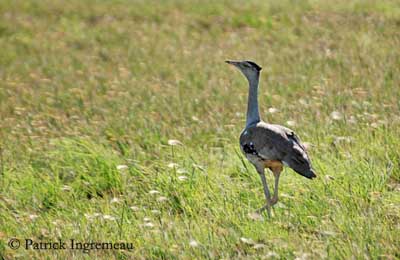
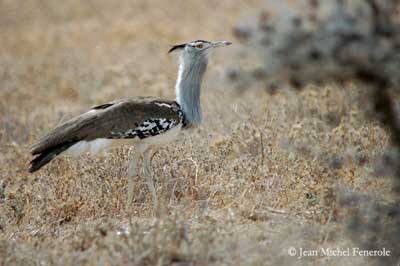
Australian Bustard - Ardeotis australis
The Denham’s Bustard throws the head backwards, drops its wings and erects foreneck, breast and belly feathers, becoming as a conspicuous ball visible over some kilometres. Then, it walks and displays alternatively, repeating the sequences several times.
The Chlamydotis bustards perform “trotting-displays”, with also crown, neck and breast feathers ruffled and head dropped backwards. They perform zig-zags, circles, lines and curves, running for about one or two minutes before to stop abruptly.
The Bengal Florican of genus Houbaropsis has similar terrestrial displays, but in addition, it performs a flight display in which it rises with clapping wings into the air and then descends while uttering several “chik” calls close to the ground, and rises sharply again with quivering wings, stalls a few moment and drops steeply to the ground.
The heavier Black-bellied Bustard performs a flight displays over 50-200 metres at about 7-15 metres high, and then, glides over 50-150 metres with V-shaped wings, repeated several times. But it also performs terrestrial displays with similar posture that other bustards, while uttering a groaning “oooo” before to throw the head backwards and utter other sound, a rumbling snore and a dry “pop”.
The Hartlaub’s Bustard has similar displays but with lower volume.
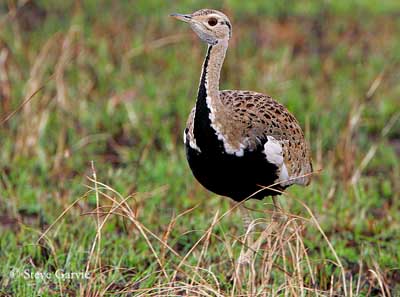
Black-bellied Bustard
Lissotis melanogaster
Southern and Northern Black Korhaans seem to have similar display-flights, and stand and call from prominent points such as termite mounds. The flying males often pursue each other.
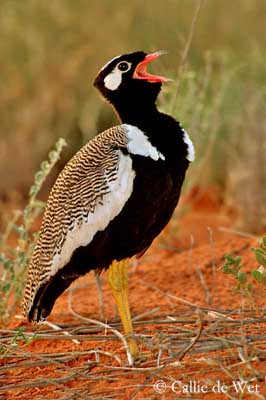
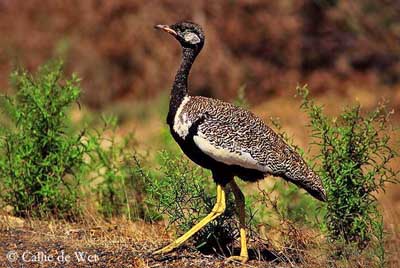
Northern Black Korhaan - Afrotis afraoides
Red-crested Korhaan and Buff-crested Bustard have more vertical than horizontal aerial displays. The birds fly up vertically at about 20-30 metres, and after a semi-somersault with feet up and head back, they drop as a fluffed-up ball to the ground, ending in a glide before the impact. On the other hand, the Savile’s Bustard has never been seen performing aerial displays, or this behaviour remains unrecorded.
The three species do not use exposed or raised sites and remain more inconspicuous than others.
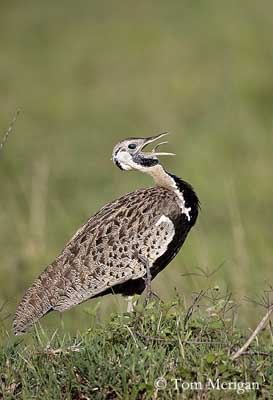
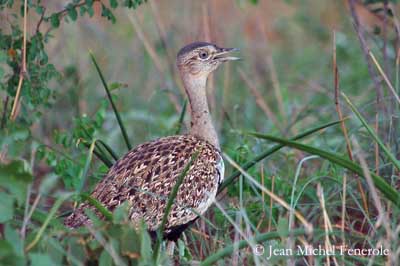
Black-bellied Bustard - Lissotis melanogaster
The Little-Bustard performs “jumping-display” from a stall, with a short burst of foot-stamping, and then it leaps 1-5 metres into the air and gives snort calls while the wings produce the typical “sisisisi”. This display lasts about one second.
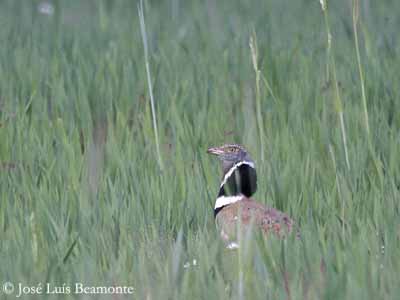
Tetrax tetrax
The lesser Florican also performs short leaps just above the grass, but at the peak of the breeding season, it may perform about 500 leaps per day, often from a chosen stall within the territory. It stands erect and stamp its feet and abruptly, it crouches and jumps into the air with flapping wings to a height of 1-5 metres. Then, it uses the half-opened wings as parachute to descent.
Copulation occurs after long sequences of behaviour, mainly in the larger species. In several species, males chase females for long periods and peck repeatedly at female’s head.
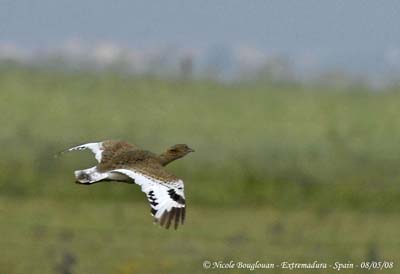
Little-Bustard Female
Tetrax tetrax
The female is entirely responsible after the copulation for the nest-site selection, incubation and rearing of the young.
The nest in on the bare ground, or may be scraped clear of vegetation, sometimes slightly moulded and occasionally rimmed with bits of grass pulled down.
It is usually near bushes, clumps of tall grasses or other weak cover, in order to avoid sitting in a complete open area, even if some nests have been found in open country.
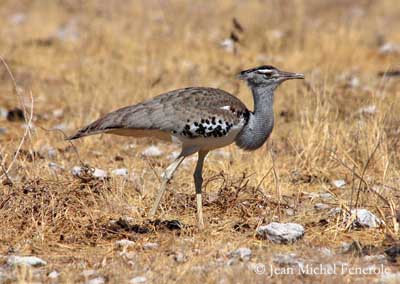
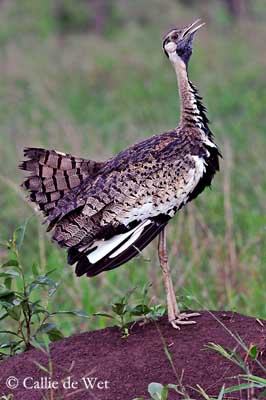
The clutch size is often 2-3 eggs, although the largest species may lay 4 eggs. The smallest Lesser Florican and Little Bustard lay 3-5 eggs.
The incubation lasts about three weeks in the Little Bustard, 24-25 days in the Australian and Great Bustards, and between these extremes for the other species.
The young are precocial but they require several hours, one day or more to be able to walk. At this moment, the female leads them from the nest at any secure site and broods them for the night. She pecks gently at them to draw their attention to food items, or drop them in front of the young. But they learn very quickly how to feed themselves. Parents and young utter quiet purrs and trills as contact calls.
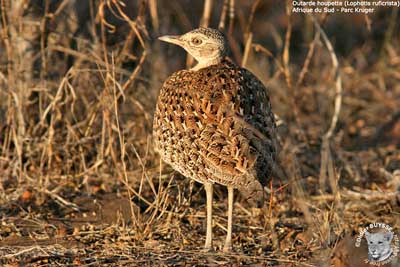
Red-crested Korhaan Female
Lophotis ruficristata
The young fledge about 4 to 5 weeks later but they do not take flight before some weeks more. They are full sized several months after fledging, and may remain with the female until the autumn, sometimes more.
The sexual maturity occurs between one and six years of age according to the sex and the species.
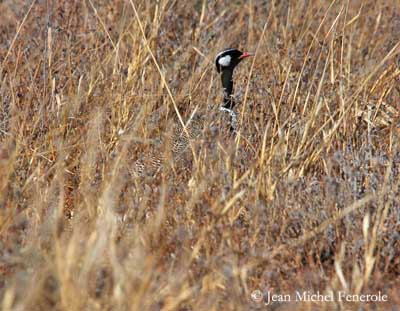
Southern Black Korhaan
Afrotis afra
Bustards are found exclusively in the Old World, from Eurasia to Australia. We can found the greatest diversity in Africa.
Bustards are usually sedentary or dispersive, but some species are strongly migratory such as Great, Little and Houbara Bustards living in Eurasia through Central Asia to eastern Russia and China. These three species must move southwards during the long, cold winters, from their steppes into warmer areas.
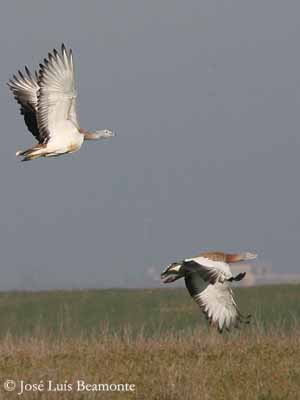
Otis tarda
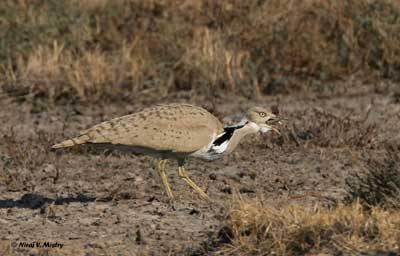
Houbara Bustard
Chlamydotis undulata
In the remainder of their range, these bustards are largely sedentary or dispersive rather than migratory. They perform some movements after the breeding season, and disappear from one region to reach another one in the same country.
In Africa, bustards often wander according to the rainfalls, others are strongly resident and move over short distances.
In India, the Lesser Florican is known to travel very long distances with the seasons.
The largest species migrate fairly low from the ground and in small groups, whereas the smaller species fly higher and in large flocks. These movements take often place at night.
But the migrations of these birds are poorly known and need confirmation.
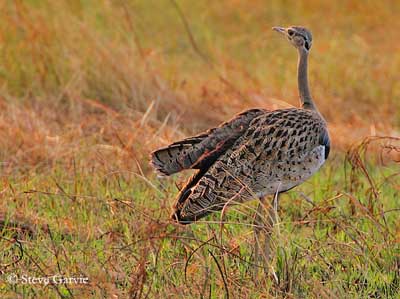
Black-bellied Bustard
Lissotis melanogaster
All bustards are threatened by intensification of agriculture, changes in their habitat such as more cattle, human disturbances with roads and building developments and also hunting in some parts of the range. Declines occur in all species, more or less important, but all with the same causes.
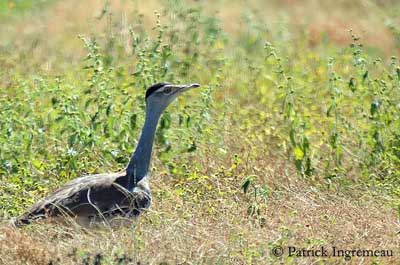
Ardeotis australis
Conservation of bustards is possible through the protection of their habitat with creation of National parks and reserves, maintenance of low-intensity farming over large areas and land without human disturbances.
Hope we will still enjoy in the future the wonderful displays of these stunning birds!
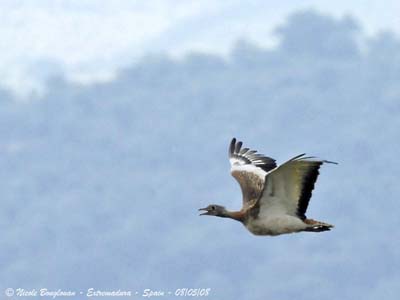
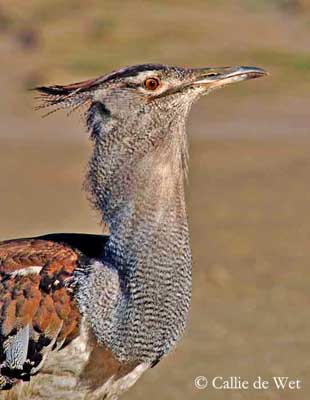
Otis tarda